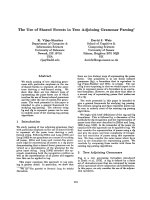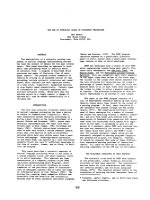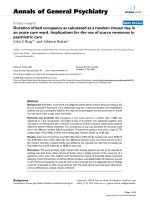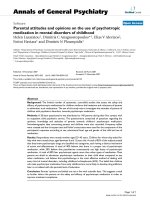The Use of Grammatical Metaphors in Barack Obama’s Presidential Nomination Acceptance Speech
Bạn đang xem bản rút gọn của tài liệu. Xem và tải ngay bản đầy đủ của tài liệu tại đây (140.56 KB, 5 trang )
The Use of Grammatical Metaphors in Barack
Obama’s Presidential Nomination Acceptance Speech
Lê Thu Trang
Trường Đại học Ngoại ngữ
Luận văn ThS. Chuyên ngành: English Linguistics; Mã số: 60 22 15
Người hướng dẫn: Prof. Dr. Hoang Van Van
Năm bảo vệ: 2011
Abstract: This thesis focuses on the use of grammatical metaphor in Barack Obama’s Presidential
Nomination Acceptance Speech. To fulfill this aim, the concept of “grammatical metaphor” is
examined. The thesis starts by explaining the notion of “metaphor” in general and distinguishes
lexical metaphor from grammatical metaphor in particular. Then, a study on grammatical metaphors
in Barack Obama’s Presidential Nomination Acceptance speech is implemented based on the
theoretical background of Halliday (1994) and Halliday & Matthiessen (1999). This is a descriptive
research with both quantitative and qualitative techniques in data analysis. Two types of grammatical
metaphors are ideational and interpersonal metaphors are densely used from the text. In ideational
metaphor type, Barack Obama mainly used type 1 (quality → thing), 2 (process → thing), 5 (process
→ quality), 6 (circumstance → quality), 13 (thing → various) with high frequency. In interpersonal
metaphor type, metaphor of mood and metaphor of modality are explained and illustrated to highlight
the attitude and emotion of the speaker.
Keywords: Tiếng Anh; Ẩn dụ; Ngữ pháp; Diễn văn
Content
CHAPTER 1
INTRODUCTION
1.1. Rationale
Metaphor is a well-known phenomenon in language. Thus, it has received attention in a myriad of
disciplines, including philosophy, linguistics, literary theory, semiotics, stylistics, psychology, pedagogy and
so on. Halliday, the author of the famous work “An Introduction to Functional Grammar” is one of the
linguists who spent long time to study on metaphor in general and grammatical metaphor in particular. He
recognized that lexical metaphor which traditional researches always mentioned is only one aspect of
metaphor and there is a strong grammatical element in rhetorical transference which is called grammatical
metaphor.
In addition, in this work, Halliday states that “metaphorical modes of expression are characteristic of all adult
discourse”. Therefore, I believe that all speeches can have included this phenomenon. It is also the reason
why I chose one famous speech of a famous President to examine grammatical metaphor used in it.
Moreover, now Barack Obama is an American President who is famous for not only his talent in political
field but also in numerous persuasive speeches because the language he chooses always makes his speech
powerful and convincing. One of the strategies that we are easy to recognize in all his speeches is using not
only lexical metaphors but also grammatical metaphors to make the discourse vivid and easy to understand
for all classes of citizen.
In conclusion, I chose this topic because of my interest in metaphor in general and grammatical metaphor in
particular; the appearance with high frequency of metaphor in adult speeches and the admiration to American
President Barack Obama’s powerful and convincing speeches.
1.2. Aims of the study
This study aims at examining the use of metaphorical modes of expression in Barack Obama’s Presidential
Nomination Acceptance Speech from a systemic functional perspective.
Features of grammatical metaphor used in this speech will be analyzed following the approach of systemic
functional linguistics to understand the roles of grammatical metaphors in developing and structuring this
discourse.
1.3. Scope of the study
This study attempts to look at how Barack Obama uses grammatical metaphors in his Presidential
Nomination Acceptance Speech.
The analysis will follow Halliday’s work “An Introduction to Functional Grammar” as the framework and
Obama’s Presidential Nomination Acceptance Speech will be taken as source of data for illustration.
1.4. Method of the study
Since the thesis sets its main objective of investigating the use of grammatical metaphor in Barack Obama’s
Presidential Nomination Acceptance Speech, it is a descriptive research which reexamines the senses in
which the grammatical metaphors are used. The techniques involved in data analysis are both qualitative and
quantitative.
1.5. Format of the study
The study is composed of four chapters
Chapter 1: Introduction ─ presents the rationale, the aims, the scope, the methodology and the format of the
study.
Chapter 2: Literature Review ─ provides the theoretical background of the study. It examines aspects of
metaphor and focuses on the nature of grammatical metaphor.
Chapter 3: The Study ─ is the main part of the study which investigates the use of grammatical metaphor in
Barack Obama’s Presidential Nomination Acceptance Speech.
Chapter 4: Conclusion ─ summarizes the main contents of the study and offers implications for teachers and
makes suggestions for further studies.
REFERENCES
1. Berry, M. (1975/7), Introduction to Systemic Linguistics 1 & 2, Batsford, London.
2. But, D., R. Fahey, S. Spinks and C. Yallop. (1995), Using Functional Grammar: An Explorer's
Guide, Macquarie University, Sydney.
3. Downing, A. & P. Locke. (1992), A university course in English grammar, Prentice Hall, New York.
4. Eggins, S. 1994, An Introduction to Systemic Functional Linguistics, Pinter, London.
5. Fries, P. H. (1981), On the Status of Theme in English Arguments from Discourse, Forum
Linguisticum 6.1: 1-38.
6. Galperin. I. R. (1981), Stylistics, Vyssaja Skola, Moscow.
7. Gerot, L. and P. Wignell. (1994), Making Sense of Functional Grammar: an Introductory Workbook,
N.S.W: Antipodean Educational Enterprises, Cammeray.
8. Halliday, M.A.K. (1978), Language as Social Semiotic: the Social Interpretation of Language and
Meaning, Edward Arnold & University Park Press, London & Baltimore.
9. Halliday, M.A.K. (1994), An Introduction to Functional Grammar, Edward Arnold, London.
10. Halliday, M.A.K. and Matthiessen, C.M.I.M. (1999), Construing Experience through Meaning: A
Language-Based Approach to Cognition, Cassell, London.
11. Halliday, M.A.K. & J. R. Martin. (1993), Writing Science: Literacy and Discursive Power, Falmer,
London.
12. Halliday, M.A.K. & R. Hasan. (1985), Language, Context and Text: a
Social Semiotic Perspective, Vic: Deakin University Press, Geelong.
13. Kress, G. (ed.). Halliday (1976), System and Function in Language, Oxford University Press,
London.
14. Lock, G. (1995), Functional English Grammar: an Introduction for Second Language Teachers,
Cambridge University Press, Cambridge.
15. Martin, J. R. (1985), Systemic Functional Linguistics and an Understanding of Written Text,
Department of Linguistics, University of Sydney.
16. Martin, J. R. (1992), English Text: System and Structure, Benjamins, Amsterdam.
17. Martin, J. R. & R. David. (2003), Working with Discourse: Meaning beyond the Clause, CPI Bath,
Great Britain.
18. Morley, D. (1985), An Introduction to Systemic Grammar, Macmillan, London.
19. Do Tuan Minh. (2001), An Investigation into Grammatical Metaphor in English Scientific Discourse,
Hanoi National University, College of Foreign Languages.
20. Ravelli, Louise. (1988), Grammatical Metaphor: an Initial Analysis, Steiner & Veltman (ed.),
Pragmatics, Discourse and Text: Explorations in Systemic Semantics, Frances Pinter, London.
21. Simpson, Paul (2004), Stylistics, Routledge, London.
22. Taverniers, Miriam. (2004), Grammatical Metaphors in English, Moderna Spark.
23. Thompson, G. (1996), Introducing Functional Grammar, Hodder Education, Londono.
24. Hoang Van Van. (1997), An Experiential Grammar of the Vietnamese Clause: A Functional
Description, Unpublished Ph.D. Dissertation: Department of Linguistics, Macquarie University,
Australia.
25. Hoang Van Van. (1999), “A Preliminary Inquiry into the Nature of Grammatical Metaphor”, (In)
Journal of Science, (No 3), VNU.
26.









